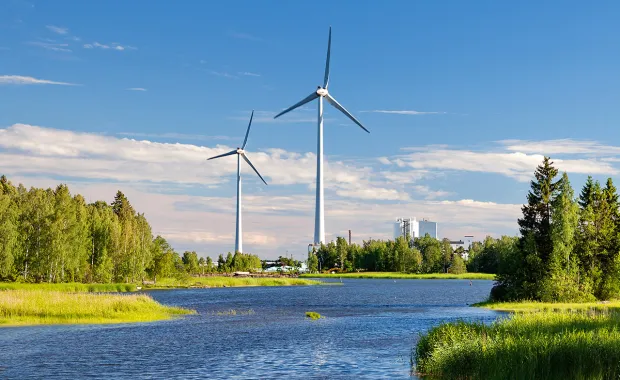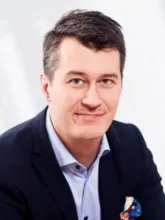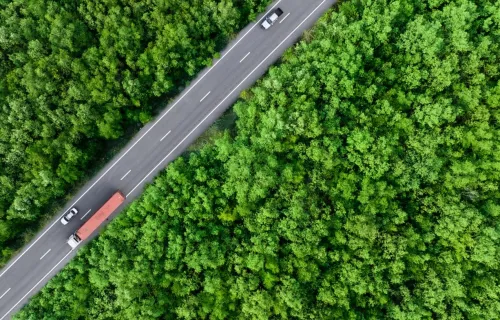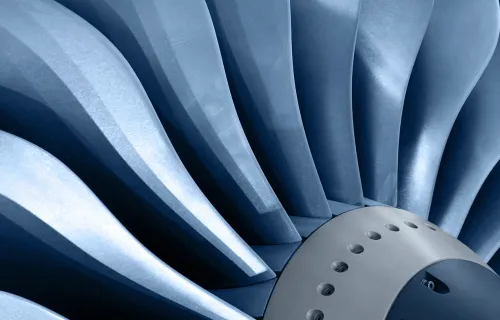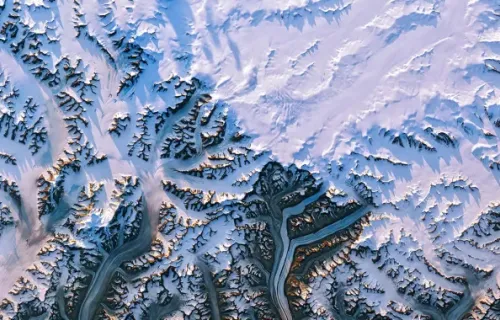Our latest Energy Transition Talks podcast explores the future scenarios that Fingrid (Finland’s state-owned transmission network operator) develops to improve their strategic planning and keep them on course to meet Finland’s net-zero targets. Fingrid executives Mikko Heikkilä, head of strategic grid planning, and Risto Kuusi, senior expert in strategic planning, speak with our energy industry lead in Finland about the goals and benefits of their scenario planning approach.
|
Mikko Heikkilä |
Risto Kuusi |
Future scenarios all meet carbon neutrality targets
Fingrid’s future scenarios are a novel, efficient way to project the future using a probabilistic approach of what might happen and how to prepare. The scenarios have implications for Finnish energy markets as well as in the Nordics and more broadly in Europe.
As part of their every-second-year planning cycle for their main grid, Fingrid drafted four scenarios for the future to ensure the grid will serve its purpose. A common driver for all scenarios is meeting Finland’s target to become carbon neutral by 2035.
The four scenarios are:
- Power to products, which assumes that Finland becomes a major industrial hub for power to products like fuels, materials and chemicals
- Hydrogen from wind, which assumes that Finland becomes a major exporter of green hydrogen
- Windy Seas, which looks at large-scale expansion of offshore wind compared to onshore wind in the other scenarios
- Local power, which looks at distributed solar, distributed batteries and even small modular nuclear power in Finland in 2035
Monitoring up to the point of investment
Scenario planning enables Fingrid to identify necessary investments. Where needs overlap all four scenarios, “These are the no brainers,” according to Mikko. They also identify investments that may be needed in one or two scenarios. So, if the future points toward a certain scenario (e.g., if offshore wind becomes competitive), they already have the high-level concepts of investments needed.
Before making new scenarios, “We track if we’re going in the direction our scenarios are pointing and if certain trends are becoming stronger than we assumed,” says Risto. “Then we adjust. We are monitoring up to the point where we make the investment decision.”
Similar approaches are used when cooperating with European colleagues. “Maybe what is unique for our process at Fingrid is that it's quite detailed and includes very active dialogue with our stakeholders and customers.”
Overestimating is better than underestimating
Fingrid factors uncertainty into their scenarios by looking at big trends. The scenarios are very modeling and data oriented, including huge amounts of data on weather conditions, cost information, demand projections and more.
Mikko observes that industry projections often can be too modest, do not adequately account for change, and do not include broad enough scenarios. “That's definitely something that we're trying to avoid,” says Risto. “Our scenarios are very bullish in terms of the future of the renewable electricity, electrification and green hydrogen. It's much easier to slow down your process than try to quickly build your grid when you are already late.”
Moving to real-time data
Forecasting weather and market behavior are increasingly important. At the same time, the market is becoming more real time. “Now we are trading electricity in 60-minute blocks, but in the near future we will transition to 50-minute trading blocks. Then all the data related to the electricity market will increase four fold basically,” says Risto.
Such data volumes make it more difficult for humans to understand how the market works. Karina observes that machine learning and artificial intelligence will be needed to help address complexities. She adds that IT experts also are looking at the integration of energy, electricity, heating and gas data, potentially treating these as one source of data and one forecast.
Rising interconnection requirements
Historically, Fingrid had 10 to 100 power plants to interconnect, but now there are 1 million electric vehicles and potentially 1 million heat pumps that could contribute to network stability and flexibility. “To benefit from all this, you need a network of interconnected components and to connect many more things into the power system,” Risto observes.
Openness and transparency
“One of our policies has been to try to make everything open and transparent, and that's also key for the market to function,” states Mikko.
The company shared their draft scenarios in a public consultation process, and met with several universities and market players to gather input. The next steps are to update the drafts based on the feedback and then design a power grid for all four scenarios.
Listen to other podcasts in the series
Read the transcript:
- 1: Introduction
-
Karina Terekhova:
Hello everyone. My name is Karina Terekhova, and today we have guests in our studio from Fingrid, which is the mostly state owned transmission network corporator of the whole Finland. We have Mikko Heikkilä here who is the head of strategic grid planning. Welcome, Mikko.
Mikko Heikkilä: Thank you. Nice to be here today.
Karina Terekhova: And we also have Risto Kuusi who is a senior expert in the strategic planning, also from Fingrid.
Risto Kuusi: Hello. Thank you for having me.
- 2: Future scenarios all meet carbon neutrality targets
-
Karina Terekhova:
We would like to talk today about the future scenarios that Fingrid has recently modeled and produced in order to assist their strategic planning. And those scenarios have a big impact on the whole energy market in Finland and probably in the Nordic countries, as well. And this is a novel, efficient and interesting way to go about projecting the future—not as a linear set of events, but rather as a probabilistic approach of what might happen and how we all should prepare for what is happening strategically. So, perhaps you could start by asking Fingrid, why did you produce the scenarios? Is that a part of some regular process and planning cycle, or is it a one-off effort?
Mikko Heikkilä:
Yeah, indeed. It's something that we do actually every second year. So, when we are planning the main grid, a main grid is bit like the model ways of the electricity network, so the biggest power lines that you can think of. And those power lines, they will be used for decades, basically. They are very long-term projects. Only the planning phase takes seven or even eight years from planning table to building process and until the grid is ready, and then they will be used for several decades, 50, 60 years, or even longer. So, that's why we have to be prepared for different kinds of future scenarios. And how we approach this is that we've been doing actually four different scenarios for the future. And the idea is in a way that whatever the future will be, we will somehow manage it and our grid will serve its purpose.
Karina Terekhova:
Indeed, and I think that the future now looks more uncertain than ever. I would like to ask whether this increasing uncertainty has influenced the modeling and their definition of scenarios, and Risto how did you even come up with the particular four choices?
Mikko Heikkilä:
Yeah, so obviously the times are uncertain and we have factored that into our scenarios. Obviously, we want to look at the big trends. There's electrification, which is going to increase the electricity demand, that's a big thing in our scenarios. There's green hydrogen, which also consumes a lot of electricity to produce, so that's a major thing. And then currently, wind and solar power are the cheapest ways to produce new electricity, bring new electricity generational line. So, that's something that we're definitely taking into account and when we look at Finland and look at the Finnish possibilities to increase, especially very competitive and abundant onshore wind power, that has a great influence in our scenarios and we are trying to ensure that we can, on our part, enable this expansion of renewable generation in Finland.
Karina Terekhova:
Did you take any input from market operators to select and shortlist the scenarios?
Mikko Heikkilä:
Yeah, actually we did. So, our process is very open and public. So, we made draft scenarios and then opened this kind of a public consultation where we collected literal feedback, but then we also met several universities and market players to discuss about the scenarios. And now we will update the draft scenarios based on the feedback that we have got.
Karina Terekhova:
So, what kind of scenarios came up from this process? What are those four scenarios that were eventually shortlisted and prioritized?
Mikko Heikkilä:
Yeah, we have four differentiated scenarios. They're different from each other and they're also different from the baseline. None of those scenarios is our best estimate, but rather they are on the outer rim, if you will. So, if I very briefly go through them:
- Power to Products, that's a scenario which assumes that Finland becomes a major industrial hub for power to X products. So, things like fuels, materials and chemicals.
- Then Hydrogen from Wind assumes that Finland becomes a major exporter of green hydrogen.
- Windy Seas looks specifically at very large-scale expansion of offshore wind compared to onshore wind in the other scenarios.
- And then Local Power looks at distributed solar, distributed batteries and even small modular nuclear power in Finland in 2035.
So, very different scenarios and the idea is that whatever happens, we would be prepared for it. One driving factor that is common for all the scenarios is the carbon neutrality target of Finland. Finland has one of the most ambitious targets to become carbon neutral already by '35, so in less than 15 years. That's something that we have, in a way, taken granted in all scenarios. They are designed so that this target is met.
Karina Terekhova:
It is great to hear that this target preserves through the changing conditions of the world, and I believe that also the electricity production will, in fact, take change in the near future. So, how do you see the change in electricity production affecting Fingrid strategies in the transmission networks, and how the scenarios will be applied in terms of electricity production?
Mikko Heikkilä:
Maybe if I start with the generation change as mentioned. Currently, if you need to bring new electricity generation online, almost everywhere in the world, wind and solar are the most competitive. So, when electricity consumption is increasing, that means that wind and solar power will increase, as well and the amount will be drastic. In addition to that, most parts of the world need to get rid of fossil fuels in electricity generation, but also in generation of heat, and industrial goods and electricity plays a role there, as well. What we are seeing is that when wind and solar are growing a lot, they're dependent on the weather, there's going to be a lot of fluctuation variation in electricity generation. And also there are some system technical fundamentals that are changing when we add more wind and solar to the system. Those are fundamental to transforming the electricity network, and the electric system and also markets and that's what we're trying to prepare for.
Karina Terekhova:
Do you see also the change that edged you towards the use of nuclear power? Because we noticed that in your scenario, pretty extreme assumptions are made about the people's acceptance of nuclear power into their backyards.
Mikko Heikkilä:
Yeah, well perhaps the small modular nuclear power should be clarified so that we're still talking about units that are hundreds of megawatts in size. So, they're located in cities but they're not something like your rooftop solar panels. You won't have your garage nuclear power station in our scenario. I think, in Finland, the approach to nuclear power has been rather pragmatic and people are willing to accept it if it's competitive. Assuming that the small scale of natural power would become competitive, we assume that it would be present in Finland, as well.
Risto Kuusi:
But just to make it clear, so we have included the SMRs, the small-scale nuclear reactors only in one of the four scenarios. So, in a way we are not counting that will be the future, but we are trying to get credit for in case the SMRs will fly.
Karina Terekhova:
Clear. And that will affect their transmission network in a different way from, for example, all kilowatt, the big nuclear power stations because of the distribution of the transmission in this case.
Risto Kuusi:
Yeah. Well, they are smaller so maybe for the system-wise they're a bit easier to handle than those big units. And then if we compared to, let's say, wind power, which is very volatile and weather dependent, and of course, the benefit of nuclear risk that it's certain, it worked well and gives this kind of a base load type of generation.
- 3: Monitoring to the point of investment
-
Karina Terekhova:
Let's talk about the examples of how do you plan to use the scenarios in their strategic planning for the electricity production. So, how does the scenario trigger a change in Fingrid investment into other transmission networks? And what kind of signals does it give to our energy markets?
Mikko Heikkilä:
The next step in our process is that we design a power grid for all of these four scenarios. So, we do quite detailed designing work, create new in the connectors and power lines on planning table. And, by doing that, we see that what kind of investments are needed in different scenarios and especially those investments that, in a way, overlap between the four scenarios that are needed in, let's say, three or four scenarios.
Those are something that we call, in a way, “no brainer.” Those we have to do anyways, whatever the future is and then we will include that kind of investments in our 10-year network development plan and take next steps in the planning, like permitting and rule selection and so on, continue the planning on one detail level. We will also identify a bunch of other investments that are maybe needed in one or two scenarios and those we keep as concept solutions. So, if the future is pointing to the direction of certain scenario, let's say if show wind comes profitable and competitive in Finland, then we have identified already some high-level concepts of those investments that we're going to need in that case.
Karina Terekhova:
Thank you. And Risto, is the modeling behind the scenarios, covering also those trigger events that Mikko is talking about? So, how will you know that a certain scenario started growing or started happening?
Risto Kuusi:
So, obviously then, when the scenarios are done and before we make the next set of scenarios, we're continuously monitoring what's going on. All the time we are seeing interest to invest in the new technologies and we are seeing projects that are being initiated and investment decisions being made. So, then we're tracking now that are we going to the direction that our scenarios are pointing and is there a certain trend that are becoming stronger than we maybe assumed in the scenarios? Is there a particular scenario that seems to be realizing a particular trend taking place? And then we adjust. So, every other way we do this main grid development plan where we reflect the next 10 years and the investments that we need to make there and all the time we are monitoring. So, even if we have a 10-year investment plan, that doesn't mean that all those in investments are set in stone, but rather that we are monitoring up to the point where we make the investment decision.
Karina Terekhova:
Interesting. That means that you are raising clearly a degree of preparation for action in case of various events take place and not define a strategy as a timeline, as a clear one directional investment plan that seems wise in the changing world and with multiple factors that will affect electricity markets. Typically, so far, we have seen a more linear scenarios of especially electricity energy development and we appreciate this really as a much more flexible approach. And would you say that this is a kind of innovation in energy sector to have this modeling and to try not to predict the future but rather to model the future in various directions and be prepared?
Mikko Heikkilä:
Yeah, you could say so. Similar approaches used also on the European level when we cooperate with our European colleagues and SOE, which is our joint organization. So, we are developing different kinds of scenarios and trying to model the markets and the grid for that. Maybe what is, in a way, very unique, at least I like to think for our process at Fingrid, is that it's quite detailed, first of all, and then the customer engagement in a way. So, we are having this very active dialogue with our stakeholders and customers, so they really can have their say to our scenarios. So, in a way, I like to think that they are not just Fingrid scenarios, but they are Finland's scenarios for the future.
Karina Terekhova:
You can testify to that. And we also participate in the webinars that Fingrid held, both while scenarios were baking and also in presenting the scenarios at the end of August to the energy markets. Do you plan to continue communication on the same level so that the whole market can be alerted? Also, what you believe in which scenario Fingrid believes starts to realize so that the market can act accordingly?
Mikko Heikkilä:
Yes, definitely. So, we will continue this process during this Autumn. We're going to have a next webinar maybe end of year or so and some other customer events and, like I said, this kind of a vision work is done every second year and also this 10-year network development plan is public and open and will be consulted. So, those are in a way the next steps for us. And, of course, when the time goes by we will update the scenarios accordingly.
Karina Terekhova:
So, we can also say that there is a wide consensus, at least in the Finnish energy market, about those scenarios and about the priority things that we should prepare for?
Mikko Heikkilä:
Yeah, I really hope so. I think where we have very strong consensus is, first of all, the need for the clean and green and affordable electricity. It's pretty clear that the power consumption will actually increase significantly during the next 10, 15 years, maybe even 50% or even more.
And then, where we also seem to very much agree with our customers is about the possibilities of Finland. So, Finland is a quite big country actually, but we are only 5.5 million people here. There's plenty of land to be utilized for the green energy and our wind conditions here up in the north. They're quite competitive, maybe not the best in the EU but still quite competitive. Finland actually has huge potential to build, especially onshore wind. And this is something that we are having or seeing now at Fingrid. More and more investors are knocking our door and asking if they can invest in Finland and connect to the grid. And first it was maybe the wind power producers, but now we are also seeing that those industry actors who are utilizing the clean and affordable power, like data center actors and hydrogen producers and so on, they are also behind our door and would like to invest in Finland.
Karina Terekhova:
That's great to hear, and obviously in producing those scenarios, it's not your everyday exercise of linear projection of past reports into the future. So, Risto probably has utilized plenty of input data to account for those choices and to justify the scenarios. So, how would you describe their purely data and IT-related challenges in producing scenarios?
Risto Kuusi:
Yeah, so our scenarios are definitely very modeling-oriented and very data-oriented. We are running fundamental modeling. We are including huge amounts of data into the process starting from, for example, weather conditions. How has the wind been? How has the solar radiation been? What about temperatures and rainfall? And all these things that actually influence great degree in the electricity markets because of the huge amount of weather depend and generation and consumption that we have.
And then we are combining all this information with, for example, cost information and projections for demand and making fundamental scenarios where we are trying to model how would rational actors behave if the world developed like we have depicted in our scenarios. And I think that's a very solid approach in the sense that we're not just coming up with some numbers or coming up with some storyline and leaving it at that. But we're actually modeling it and we're learning a lot when we're trying to think what would the industrial players and electricity producers do if the world would develop like we have thought about.
- 4: Overestimating is better than underestimating
-
Karina Terekhova:
You have told us that this is not the first time that Fingrid actually models the future. How did the past projections fair? So, did we see their developments in the direction of your scenarios that you had made in past years?
Risto Kuusi:
I think, generally speaking, and I think this applies for everybody in the energy industry, is that even if you have been right about that wind power is going to be a big thing and solar is going to be a big thing and we're probably going to see a lot of electrification and hydrogen. I think almost all the projections and scenarios have always been too modest and not taking the change into account enough and not making broad enough scenarios. And that's definitely something that we're trying to avoid here. So, our scenarios are very, I would say bullish, in terms of the future of the renewable electricity and electrification and green hydrogen. So, let's hope that we are not undershooting.
Karina Terekhova:
I see. So, the trouble, rather, is in underestimating the change, rather than overestimating?
Risto Kuusi:
At least it has been. So, let's see how this time we fare with these scenarios. It also makes sense to, let's say, plan big and be prepared for significant growth. It's much easier to, in a way, slow down your process than if it happens. So that let's say the clean energy is not growing that quickly as you anticipated. That's much more easier scenario for you to handle as a transmission grid operator than trying to quickly somehow run behind the green investments and build your grid when you are already late.
- 5: Moving to real-time data
-
Karina Terekhova:
That's true. And assuming their need for drastic change management, how do you see the IT sector supporting you and supporting the energy markets in those scenarios?
Risto Kuusi:
Well, the electricity system is in great change and it's been quite centralized system with few big power plants, but now it's becoming decentralized there will be much more actors, there will be new type of generation, which is weather dependent, it's maybe more difficult to forecast and predict how it behaves in the market. So, everything that is related to the forecasting is of weather and behavior around the market is becoming more and more important. On the other hand, the market is becoming more and more real-time because back in the day, it's been quite easy to forecast and control the power plants based on the needs of the customers. But now you have to utilize the wind and solar as best way you can.
So, in practice, this means that everything is becoming more real-time and you have to make the electricity trades closer to delivery hour and delivery time.
And that we can also see in the market. So, now we are trading electricity in 60-minute, 1-hour blocks, but already in the near future we will transition to 50-minute trading blocks and that will, of course, make, we will all the data that is related to the electricity market will be then fourfold, basically. And, of course, this also means that it's more difficult for a human person to understand how the market actually works. So, you have to try to optimize everything, basically, that you can data crunch, and so on. In a way, the data quality becomes more and more important. You have to be able to trust your systems and you cannot just look it by your own eyes and make a decision based on your gut feeling, but you really have to trust your data and then it means that it has to be great quality.
Karina Terekhova:
So, it seems that the forecasting accuracy that will increase and, at the same time, become much challenging and will require larger quantities of data to be accurate. And probably the elements of machine learning and artificial intelligence will be needed to capture the complexities of demand and consumption for a cost at the same time. And that IT might help you there.
- 6: Rising interconnection requirements
-
Risto Kuusi:
Yes, definitely. And maybe to add on top of that, I think one of the trends is that everything is becoming more interconnected and in the electricity system that might mean that when historically you had maybe you had 10 or 100 power plants, but now you have actually 1 million electric vehicles that could contribute to keeping the system stable and benefiting from cheap electricity when it's available.
Someone needs to kind of tell the EVs when it's a good time to charge. And the same similarly to, we might have more than a million heat pumps in Finland, which creates flexibility potentially if that can be unleashed and all this kind of... To benefit from all this, you need to have a network of interconnected components and interconnect much more things into the power system. So, I think that also is a great IT challenge and something that needs to be solved.
- 7: Openness and transparency
-
Karina Terekhova:
Indeed, IT is looking at the intersectional integration of energy, electricity, heating and gas data. And, in the future, it's likely to be treated as one source of data and one forecast. So, I believe that this is the way for the IT to go. Last but not least, perhaps it's interesting that while we are openly discussing their possible future and we are actually detailing their future scenarios clearly for everyone to hear, at the same time the concerns about security of both operations and data grow. And how does Fingrid see their future challenges for this maintaining both security and transparency of data?
Mikko Heikkilä:
Well, that's a good question. Maybe one of our policy has been that let's try to make it everything as open as possible. So, when you don't have that much data that you are not able to disclose to the public, then it's, of course, bigger problem. We've been advocating that basically all the market data that could be possible, let's make it open and transparent and that's also key for the market function. So, then when the data is available and different market players can reach it, it will also facilitate the competition in the market. So, it's not just something that the, let's say, the big players can have, but also the new entrants and smaller players are able to reach the electricity market data.
Karina Terekhova:
Thank you. I think that we have covered a wide ground about the energy markets future in Finland and their strategic investments at Fingrid. And this is something that is of interest not only for Finland but also in the Nordics and wider in Europe. And we see that also in other part of the Nordics similar efforts take place. So, thanks a lot for this input Mikko and Risto and with that, we close our discussion.
Mikko Heikkilä: Thank you.
Risto Kuusi: Thank you.
